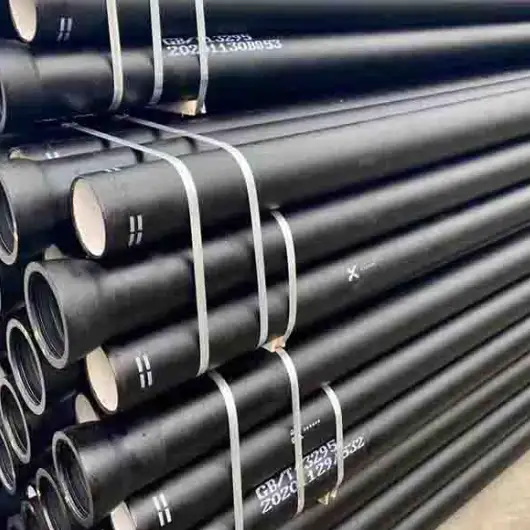D5506, also known as SAE J434 D5506, is a grade of ductile cast iron characterized by its nodular graphite structure. This grade is part of the SAE J434 series, which includes various ductile iron grades used in engineering applications. D5506 is particularly noted for its combination of strength and ductility, making it suitable for components subjected to moderate to high stress.

1. Chemical Composition and Mechanical Properties
The chemical composition of D5506 typically includes:
-
Carbon (C): 3.4–3.8%
-
Silicon (Si): 2.35–2.75%
-
Manganese (Mn): 0.025–0.08%
-
Magnesium (Mg): 0.05–0.055%
-
Phosphorus (P): ≤0.04%
-
Sulfur (S): ≤0.02%
Mechanical properties include:
-
Tensile Strength: Approximately 80,000 psi (552 MPa)
-
Yield Strength: Approximately 55,000 psi (379 MPa)
-
Elongation: 6%
-
Hardness: Brinell Hardness Number (BHN) 187–255
-
Density: 0.256 lb/in³ (7.1 g/cm³)
-
Thermal Conductivity: 250 Btu/hr·ft·°F (36 W/m·K)
2. Global Equivalents and Standards
D5506 corresponds to several equivalent grades in international standards:
-
ASTM A536: Grade 80-55-06
-
ISO 1083: Grade 500-7
-
DIN: GGG-50
-
EN: EN-JS500-7
-
JIS: FCD50
-
GB: QT500-7
These equivalents ensure that D5506 can be used interchangeably in various global markets, provided that the mechanical properties align with the requirements.
3. Manufacturing Processes and Heat Treatment
D5506 is typically produced using sand casting or centrifugal casting methods. The casting process involves pouring molten iron into molds to form the desired shape. Heat treatment processes, such as annealing, can be applied to enhance specific properties like strength and hardness.
The microstructure consists primarily of pearlite with a small amount of ferrite, contributing to its excellent machinability and moderate strength.
4. Applications in Various Industries
D5506 ductile iron is utilized in industries where moderate strength and high machinability are required. Applications include:
-
Automotive: Engine components, suspension parts
-
Agricultural Machinery: Gearboxes, housings
-
Industrial Equipment: Pumps, valves
-
Construction: Structural components
Its combination of properties makes it suitable for components subjected to moderate stress and requiring precise machining.
5. Market Pricing Trends and Factors
The price of D5506 ductile iron varies based on factors such as raw material costs, production methods, and market demand. As of recent data, the price for rough castings ranges between $1,300 and $1,600 per ton. Additional costs may arise from machining, heat treatment, and surface finishing processes.
6. Comparison with Other Ductile Iron Grades
| Grade | Microstructure | Tensile Strength | Applications |
|---|---|---|---|
| D5506 | Pearlitic-Ferritic | ~552 MPa | Moderate stress components |
| D450/D4512 | Ferritic | ~450 MPa | High ductility, good machinability |
| D700/D7003 | Austempered | ~900 MPa | Wear-resistant components |
This comparison highlights the suitability of each grade for specific applications based on their mechanical properties.
7. Advantages and Limitations
Advantages:
-
Excellent Machinability: Due to its pearlitic-ferritic structure.
-
Moderate Strength: Suitable for components under moderate stress.
-
Good Ductility: Offers resistance to impact and shock loading.
Limitations:
-
Lower Strength Compared to Other Grades: Not suitable for high-stress applications.
-
Sensitive to Heat Treatment: Improper heat treatment can affect mechanical properties.
8. Frequently Asked Questions (FAQs)
Q1: What is the primary advantage of using D5506 ductile iron?
D5506 offers a balance between machinability and strength, making it ideal for components that require precise machining and are subjected to moderate stress.
Q2: How does D5506 compare to other ductile iron grades?
Compared to grades like D700 or D800, D5506 has lower tensile strength but offers superior machinability, making it suitable for components where ease of machining is a priority.
Q3: What industries commonly use D5506 ductile iron?
Industries such as automotive, agriculture, and industrial equipment manufacturing utilize D5506 for components like engine parts, gearboxes, and housings.
Q4: What factors influence the pricing of D5506 ductile iron?
Raw material costs, production methods, and market demand are primary factors affecting the price of D5506. Additionally, costs for machining and heat treatment can influence the overall price.
Q5: Can D5506 be heat treated to improve its properties?
Yes, heat treatment processes like annealing can enhance specific properties of D5506, such as strength and hardness, to meet application requirements.
Q6: Are there alternative materials to D5506 for similar applications?
Yes, materials like ASTM A36 carbon steel or other ductile iron grades such as D700 or D800 may be considered, depending on the specific requirements of strength, machinability, and cost.
9. Conclusion
D5506 ductile iron is a versatile material offering a combination of moderate strength and excellent machinability, making it suitable for a wide range of applications. Understanding its properties, equivalents, and market factors is essential for engineers and procurement professionals when selecting materials for specific components.

